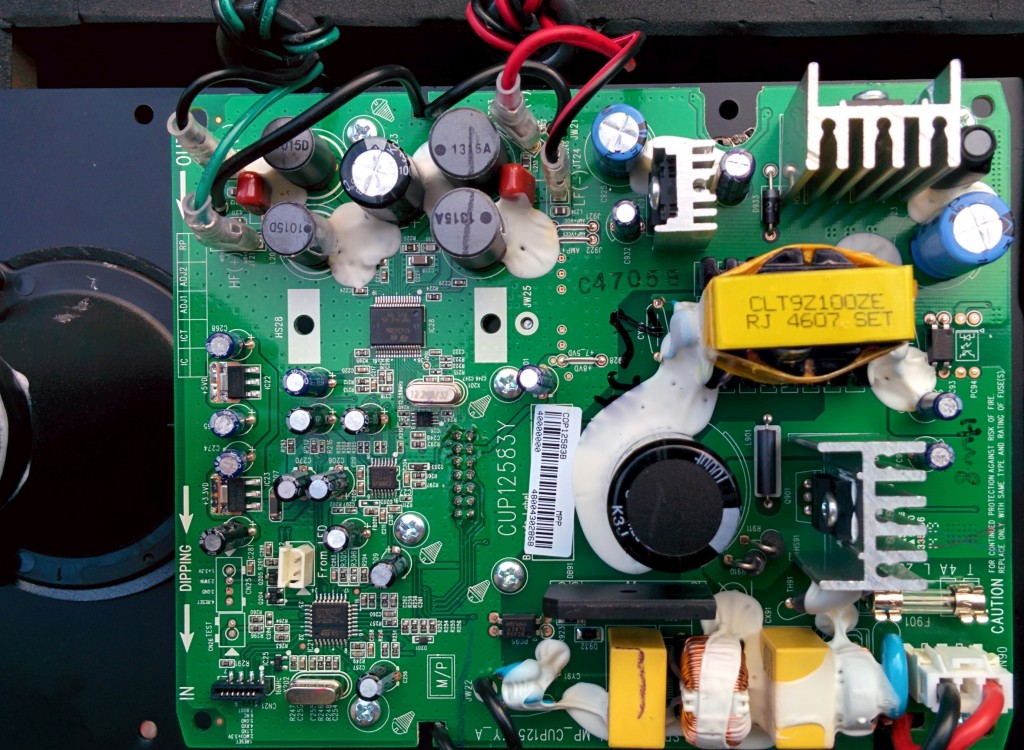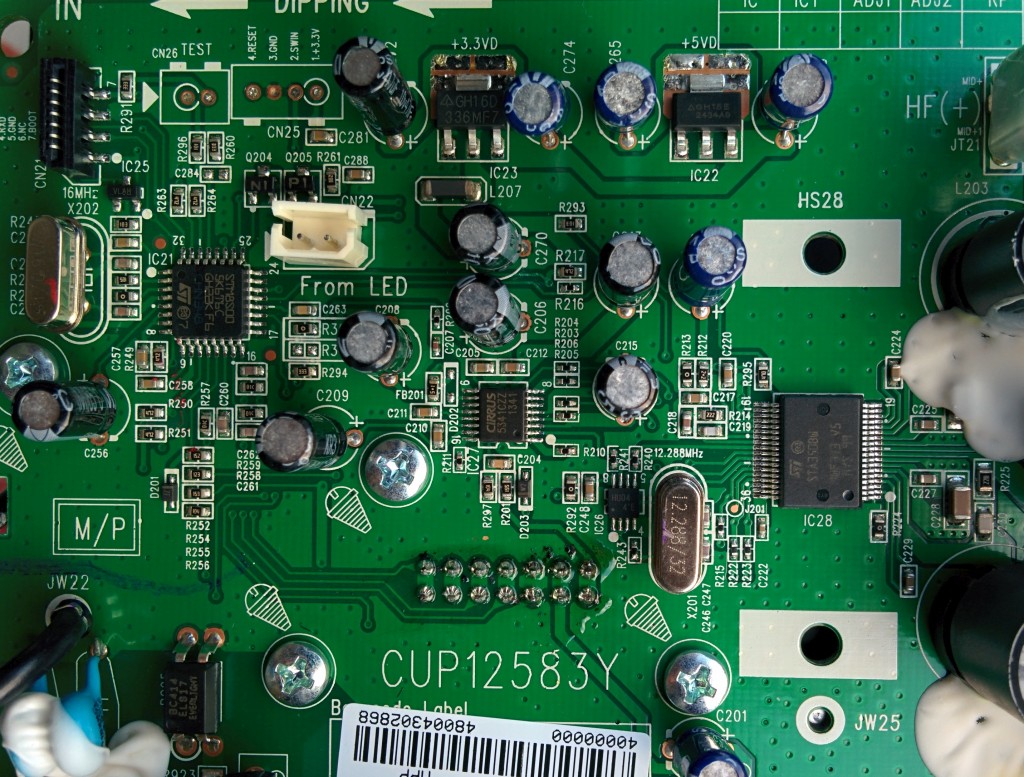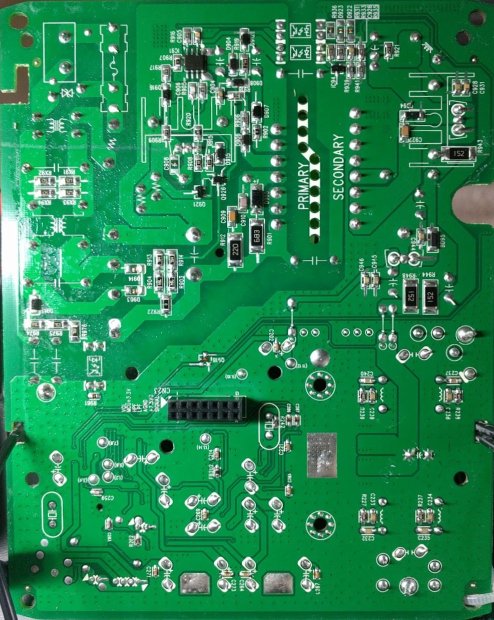JBL LSR305 Teardown and Analysis
2 June 2015
The JBL LSR305 has a space age looking waveguide that indeed does provide subjectively omnidirectional tweeter pressure, while the wide flared port has practically no wind noise. The resulting sound lacks a bit of detail, but is otherwise outstanding at its $130 price point. Surprisingly, the speaker does not offer over-power protection or any power saving capabilities, both of which could have been implemented using the existing chips. There is also a peculiar bug, which might be destructive. I am particularly interested in the design because of the switched mode power supply, digital filtering and class D power amplification.
Here are the guts, let's dive in!

The power supply takes up the right half of the board and provides fixed 19V output to the power amplifier and 8V to the rest of the digital logic (later stepped down to 3.3V and 5V). The top left quadrant has the STA350BW DSP + class D power amp chip and the output LC lowpass filters, while on the lower left there is the STM8S00 MCU, CS5341 ADC and the shared clock generator.

The heart of the board is the STA350BW (on the right above). It has 2 bridged 50W power amplifiers (hence the single rail power supply) and 4 second-order digital filters per channel, implementing the cross-over. The datasheet claims 0.09% THD+N at 1W, going to around 0.5% above 10W. The chip has no attached heatsink and certainly not required - mine idles at 40 °C, and heats up to ~60 °C during operation. The LSR308 uses the same PCB, but has a heatsink given higher operating voltage and power output.
The STM8 MCU (left) has 2 functions:
- Load up the filter coefficients and initialize the rest of the DSP.
- Read the trim switches and the gain potentiometer at the back and update the DSP config appropriately.
The drivers are an 8 Ohm tweeter and a 4 Ohm woofer. Replacing them with resistors and overpowering the system shows its 2 main weaknesses - there is no overpower protection, the amplifier just starts clipping. Even worse, the cross-overs seem to have a fixed point overflow bug and at high levels not only a sine wave is strangely modulated, but also a strong bass might cause output through the tweeter.
JBL claims 43 Hz - 24 kHz response (at unspecified attenuation). Here is my in-house frequency plot: good flatness, except for the minor smiley shape.

Frequency response. The notch at 70 Hz is a room anti-node.
Idle power consumption off the wall is just 4W. Class B monitors typically consume ~20W.
Tweeter Hiss
Unfortunately the tweeters produce audible hiss in a quiet room. Looking at the back side of the board reveals at least one problem - there is a large ground plane that transfers the 400 kHz parasitics from the power amp to the analog input, including the ADC. JBL should have used the standard in audio star topology to isolate the power section from the analog section.

The electric noise fed into the tweeter is a lot stronger than appears to the ear - I measured 1 VPP on the speaker terminal in respect to ground with an oscilloscope. The majority of the noise power is in the inaudible range.
Conclusion
Despite its weaknesses, the JBL LSR305 is a beautiful and well sounding speaker. Also don't forget that you do not need an expensive balanced audio source to drive them - with a $2 RCA to mono-jack adapter (which shorts the negative input to ground), you can easily drive a pair of the speakers from an onboard laptop/PC soundcard, phone, tablet, etc.
Here is my review of the accompanying sub - LSR310s.
Comments for JBL LSR305 Teardown and Analysis
Kevon on June 5, 2015
"The drivers are an 8 Ohm tweeter and a 4 Ohm woofer. Replacing them with resistors and overpowering the system shows its 2 main weaknesses - there is no overpower protection, the amplifier just starts clipping. Even worse, the cross-overs seem to have a fixed point overflow bug and at high levels not only a sine wave is strangely modulated, but also a strong bass might cause output through the tweeter" So How do we fix the shortcomings and enhance the speaker?
Rouslan on June 5, 2015
The fix would be to make the MCU monitor the signal, like I did in my previous post. JBL's board already has the programmer port, but we don't have the original program code to modify. Anyway, the current design might just be fine - perhaps they used high wattage drivers able to withstand all the amp can feed them.
Vladimir on December 20, 2015
Hi Rouslan. You mention you got modulated sine wave at high levels with the JBL LSR305. Did you try the +4dBu input sensitivity setting? This is recommended by JBL if you are getting any distortion. Best to use a +4dBu balanced output audio interface (DAC) and have the JBLs also set at +4dBu, which is pro audio standard. Thank you for the photos of the inside. Cheers